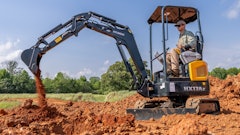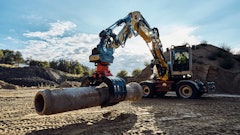
Take a moment to imagine what a jobsite of the future will look like.
Where noisy, gasoline-powered machines once rumbled and emitted exhaust, a new fleet of quiet, electric-powered machinery will dominate. Powerful, zero-turn electrified mowers will silently glide across properties, their lithium-ion battery packs providing sustained runtimes and impressive cut quality.
On a landscaping job, sleek electric stand-on blowers will quickly clear away clippings and debris without the loud drone of gasoline engines.
 Electric light towers will illuminate jobsites using clean, electric power with zero exhaust exposure for crew members working nearby.Briggs & Stratton (Vanguard)
Electric light towers will illuminate jobsites using clean, electric power with zero exhaust exposure for crew members working nearby.Briggs & Stratton (Vanguard)
With its dependable nature, engine technology has dominated the compact equipment space in applications like construction, landscaping and outdoor power tools. However, more equipment owners, contractors and end users are exploring electrified solutions as they discover their new capabilities and benefits.
Breaking Down the Benefits of Electrification
Several compelling advantages are accelerating the adoption of electrified equipment throughout industries in the compact equipment sector. To begin, the operating costs of electric-powered units can be significantly lower than their combustion engine counterparts, depending on the job at hand. With fluctuating gasoline prices, it can be difficult to predict fuel costs.
Electric equipment also requires little to no maintenance over the course of its lifetime, eliminating that expense and the associated downtime.
In addition to saving money, electrified equipment also produces zero direct emissions. This is particularly beneficial for contractors operating in enclosed, indoor spaces where emissions are an issue. The quiet operation afforded by electric equipment is another advantage, enabling work in noise-sensitive environments while improving operator safety and comfort.
Navigating Changing Regulations
Along with cost savings and operator comfort, changing emissions regulations and jobsite requirements are encouraging the adoption of electrified equipment. An increasing number of cities, jobsites and indoor facilities are instituting strict emissions regulations and noise ordinances that effectively require electrified equipment for contractors and crews to be competitive in the bidding process and in compliance. At the same time, environmentally conscious customers are more frequently asking their contractors to use low- to no-emission machinery on projects.
For many equipment owners, transitioning to electrified units is a savvy business decision that sets them up for future success as emissions regulations continue to change and battery technology evolves. Engines are a viable and important part of the compact equipment landscape, but electrification will have a significant impact and a crucial role on the jobsites of the future. Forward-thinking owners are getting ahead of the curve by acquiring electrified options today.
Making the Swap to Electric Power
Increasing demand has unlocked a range of innovations when it comes to battery pack design. For example, the advent of swappable battery packs are set to revolutionize the outdoor power equipment market. Historically, professionals have contended with loud, gas-powered machines that have significant emissions and frequent refueling needs.
 The advent of swappable battery packs are set to majorly improve the outdoor power equipment market.Briggs & Stratton (Vanguard)
The advent of swappable battery packs are set to majorly improve the outdoor power equipment market.Briggs & Stratton (Vanguard)
As battery technology continues improving, swappable pack designs will enable even more capable and robust outdoor power equipment solutions. Electrification is already transforming this industry, and swappable battery packs are key to long-term adoption. With freedom from range anxiety, compact equipment owners and operators can truly begin to experience the flexibility, convenience and optimized performance that swappable lithium-ion battery technology provides.
Evaluating Electrified Compact Equipment
Some important factors must be considered by equipment owners as they move into the electrified space. While some applications with extremely heavy-duty cycles or exceptional runtimes may still require a gas-powered solution, the advancement of battery technology is unlocking application potential across industries. It is important for equipment owners and operators to understand the range and runtime of their electrified equipment to ensure that the battery packs can provide sufficient runtime for a full workday.
Just as important as understanding range and runtime is making plans to have access to charging infrastructure or bringing enough charged batteries to complete a job if crews are working on a remote site. Whether it’s swapping depleted battery packs or recharging between shifts, robust battery charging plans and infrastructure are required to maximize productive operating times.
Equipment owners should also be aware of higher initial investments for electrified equipment. Despite offering low operating costs in the long term, electrified equipment generally carries a higher upfront purchase price. However, there may be opportunities for owners and fleet managers to take advantage of local business incentives for electrified equipment.
A final consideration is a transition in operator training requirements. As new electrified equipment comes online and is integrated into fleets, equipment operators must be trained on proper battery use, charging procedures and operating considerations unique to electrified machinery. But with the integration of intelligent battery management systems to help monitor battery health and performance, and the compact design of electric equipment, operators will find these machines an easy-to-use and intuitive addition to the jobsite.
The Future is Electrified
Envision jobsites and properties maintained by this new generation of machines—powerful yet whisper-quiet, emission-free yet highly productive. For operators, there are no vibrations, no emissions clouding their workspace and no ear-ringing noise. They can communicate clearly and then efficiently tackle the task at hand. This is what the jobsite of the future looks like as more equipment owners, contractors and fleet managers embrace electrification. The combination of performance benefits, cost savings, swappable battery technology and regulatory compliance makes electrified compact equipment an increasingly attractive addition to forward-thinking equipment owners’ fleets.





























